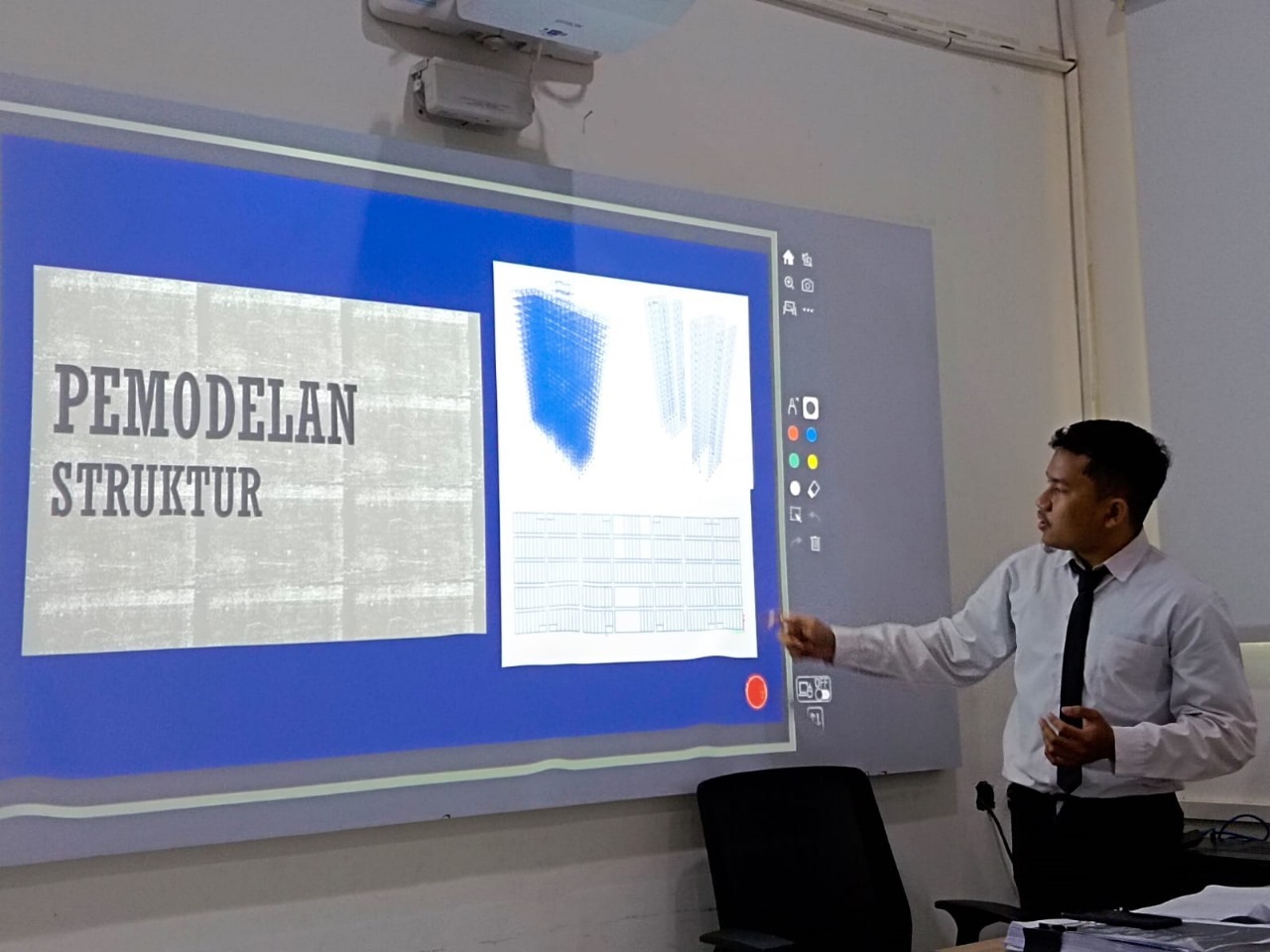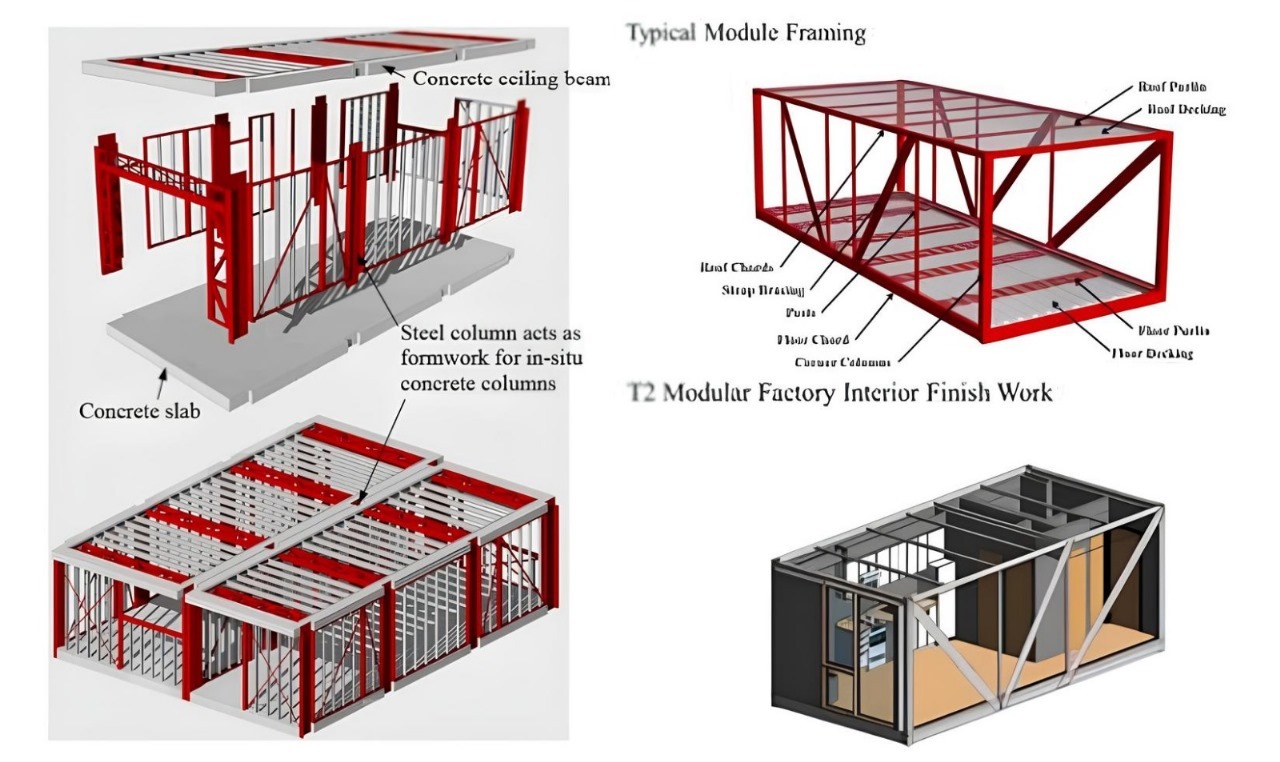ITS Students Innovate 23-Story Modular Building Structure Planning

Nanda Amar Kurniawan explains the topic of his final assignment related to structural modeling of a 23-story modular building.
ITS Campus, ITS News — The increasing demand for prefabricated modular buildings has reached the construction industry in Indonesia. Addressing this urgency, students from the Department of Civil Infrastructure Engineering at Institut Teknologi Sepuluh Nopember (ITS) have innovated a structural plan for a 23-story modular building using a Dual System of Medium Moment-Resisting Frame (SRPMM) combined with Special Concentrically Braced Frames (SRBKK).
Nanda Amar Kurniawan, a student from Civil Infrastructure Engineering, explained that this 23-story modular construction system involves the assembly of building components that are pre-produced in factories, thus reducing on-site construction time. This is different from conventional buildings that need to be designed and constructed directly on-site. “This method not only saves time but also minimizes construction waste,” he said.
Furthermore, this D4 student revealed that in his design, he chose to use SRPMM due to its high strength and flexibility. With proper planning, this system can result in a safe and durable building. SRPMM has also been widely applied to mid-rise buildings, such as office buildings, apartments, and hotels.
The Surabaya-born student added that by combining SRPMM with SRBKK in the building design, the structure gains a level of flexibility and can effectively absorb earthquake shocks. This is because SRBKK includes bracing installed diagonally, which increases the stiffness of the structure. “Despite being rigid, this system has the ability to deform and absorb seismic energy,” Amar explained.

Reference modular building structure used in Amar’s final assignment in planning a 23-storey modular building structure
Regarding SRBKK, in this building plan, the 2017 cohort student used an Inverted V-type bracing system, where both diagonal members share the horizontal load. This allows for an empty space in the center, providing access for mobility within the room. “The use of the Inverted V-shape enables openings in the center, such as doors and windows,” he said.
In addition to efficiency, this structural plan also takes sustainability into account. The use of steel as the primary material allows the building to withstand corrosion, extreme temperatures, and harsh environmental conditions, resulting in a long service life. Additionally, the construction process that minimizes waste and energy use contributes to environmental preservation.
Supervised by Ir. Ibnu Pudji Rahardjo, MS as the first advisor, and Dr. Ir. Nur Ahmad Husin, ST, MT, IPM, ASEAN Eng as the second advisor, the planning of this 23-story modular building structure not only contributes to the development of the construction industry but also has a positive impact on society. “With shorter construction times, it is hoped to support the comfort of residential living,” he concluded. (ITS Public Relations)
Reporter: Khaila Bening Amanda Putri
News Translator: Nabila Luthfiani
Related News
-
ITS Develops Four‑Legged Dog Robot with Sensors and Navigation
ITS Campus, ITS News – Institut Teknologi Sepuluh Nopember (ITS) is further solidifying its role in robotic technology
August 19, 2024 19:08 -
ITS Mathematics Alumnus Creates EEG-Based Brain Research Technology
ITS Campus, ITS News — One of the graduates of the Institut Teknologi Sepuluh Nopember (ITS) has succeeded in
August 19, 2024 19:08 -
ITS Promotes FAST-D Scholarship, Unggul, and Global Excellence Scholarship
ITS Campus, ITS News – Institut Teknologi Sepuluh Nopember (ITS) always shows its commitment in supporting students to develop their best
August 19, 2024 19:08 -
Supporting the Implementation of SPMB 2025, ITS Develops the SENOPATI Platform
ITS Campus, ITS News – Showing its contribution in the field of education, Institut Teknologi Sepuluh Nopember (ITS) has redeveloped a platform
August 19, 2024 19:08
